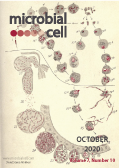Table of contents
Volume 7, Issue 10, pp. 255 - 288, October 2020
Cover: Life cycle of Plasmodium vivax (after Grassi and Schaudinn) extracted from "A text-book on disease-producing microörganisms especially intended for the use of veterinary students and practitioners" by Maximilian J. Herzog, published by Lea & Febiger (Philadelphia and New York, 1910). The image was modified by MIC. The cover is published under the Creative Commons Attribution (CC BY) license.
Enlarge issue cover
Plant and fungal products that extend lifespan in Caenorhabditis elegans
Jan Martel, Cheng-Yeu Wu, Hsin-Hsin Peng, Yun-Fei Ko, Hung-Chi Yang, John D. Young and David M. Ojcius
Reviews |
page 255-269 | 10.15698/mic2020.10.731 | Full text | PDF |
Abstract
The nematode Caenorhabditis elegans is a useful model to study aging due to its short lifespan, ease of manipulation, and available genetic tools. Several molecules and extracts derived from plants and fungi extend the lifespan of C. elegans by modulating aging-related pathways that are conserved in more complex organisms. Modulation of aging pathways leads to activation of autophagy, mitochondrial biogenesis and expression of antioxidant and detoxifying enzymes in a manner similar to caloric restriction. Low and moderate concentrations of plant and fungal molecules usually extend lifespan, while high concentrations are detrimental, consistent with a lifespan-modulating mechanism involving hormesis. We review here molecules and extracts derived from plants and fungi that extend the lifespan of C. elegans, and explore the possibility that these natural substances may produce health benefits in humans.
Variants of the human RAD52 gene confer defects in ionizing radiation resistance and homologous recombination repair in budding yeast
Alissa D. Clear, Glenn M. Manthey, Olivia Lewis, Isabelle Y. Lopez, Rossana Rico, Shannon Owens, M. Cristina Negritto, Elise W. Wolf, Jason Xu, Nikola Kenjić, J. Jefferson P. Perry, Aaron W. Adamson, Susan L. Neuhausen, Adam M. Bailis
Research Articles |
page 270-285 | 10.15698/mic2020.10.732 | Full text | PDF |
Abstract
RAD52 is a structurally and functionally conserved component of the DNA double-strand break (DSB) repair apparatus from budding yeast to humans. We recently showed that expressing the human gene, HsRAD52 in rad52 mutant budding yeast cells can suppress both their ionizing radiation (IR) sensitivity and homologous recombination repair (HRR) defects. Intriguingly, we observed that HsRAD52 supports DSB repair by a mechanism of HRR that conserves genome structure and is independent of the canonical HR machinery. In this study we report that naturally occurring variants of HsRAD52, one of which suppresses the pathogenicity of BRCA2 mutations, were unable to suppress the IR sensitivity and HRR defects of rad52 mutant yeast cells, but fully suppressed a defect in DSB repair by single-strand annealing (SSA). This failure to suppress both IR sensitivity and the HRR defect correlated with an inability of HsRAD52 protein to associate with and drive an interaction between genomic sequences during DSB repair by HRR. These results suggest that HsRAD52 supports multiple, distinct DSB repair apparatuses in budding yeast cells and help further define its mechanism of action in HRR. They also imply that disruption of HsRAD52-dependent HRR in BRCA2-defective human cells may contribute to protection against tumorigenesis and provide a target for killing BRCA2-defective cancers.
Erythrocyte phospho-signalling is dynamically altered during infection with Plasmodium falciparum
Jack D. Adderley and Christian Doerig
Microreviews |
page 286-288 | 10.15698/mic2020.10.733 | Full text | PDF |
Abstract
It is well established that intracellular pathogens mobilise signalling pathways to manipulate gene expression of their host cell to promote their own survival. Surprisingly, there is evidence that specific host signalling molecules are likewise activated in a-nucleated erythrocytes in response to infection with malaria parasites. In this paper (Adderley et al., Nature Communications 2020), we report the system-wide assessment of host erythrocyte signalling during the course of infection with Plasmodium falciparum. This was achieved through the use of antibody microarrays containing >800 antibodies directed against human signalling proteins, which enabled us to interrogate the status of host erythrocyte signalling pathways at the ring, trophozoite and schizont stages of parasite development. This not only confirmed the pre-existing fragmentary data on the activation of a host erythrocyte PAK-MEK pathway, but also identified dynamic changes to many additional signalling elements, with trophozoite-infected erythrocytes displaying the largest mobilisation of host cell signalling. This study generated a comprehensive dataset on the modulation of host erythrocyte signalling during infection with P. falciparum, and provides the proof of principle that human protein kinases activated by Plasmodium infection represent attractive targets for antimalarial intervention.










